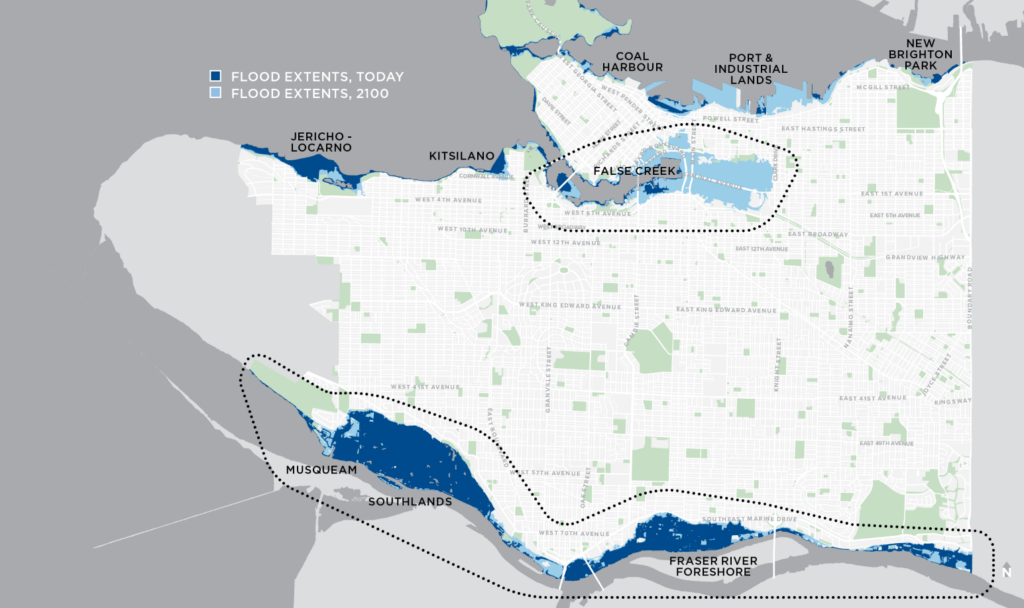More than a century ago, Squamish Chief Joe Capilano was sealing in his canoe, armed with the elk-bone spear of his ancestors, when he came upon the king of seals at the mouth of False Creek. After a short struggle, the seal king disappeared into the sea with his spear.
Chief Capilano traversed the sea for months until he found his spear in Deer Lake, along with the body of the seal king. For the rest of his life, he believed that there was a secret river connecting False Creek to Deer Lake, through which the seal must have journeyed — and he searched for it tirelessly.
For ages, Indigenous Peoples have stewarded waterways, lands, and animals, learning to live in harmony with all that was around them. This relationship to — and respect for — nature is one that guided the Sea2City Design Challenge, a key part of the City of Vancouver’s Coastal Adaptation Plan for False Creek, and its plans for sea level rise.
“A lot of the language that we use in adaptation planning is very Western,” says Angela Danyluk, a Senior Environmental Specialist at the City and a project manager on Sea2City. In adaptation planning, it’s common to hear “Resist (keep the water out), Accommodate (let the water in), Retreat (get out).”
Kees Lokman, a professor and director of the Coastal Adaptation Lab at the University of British Columbia, agrees, adding that adaptation strategies have often focused on colonial and capitalist values. "It's about protecting infrastructures, properties, and urban developments, and has led to the displacement of Indigenous communities and other marginalized groups."
False Creek
See more →
This area is the False Creek floodplain. Dark blue shows flood events we experience today and light blue shows anticipated flooding in 2100 with one metre of sea level rise.
Located in the light blue area is BC Place, Pacific Central Station, Olympic Village, Science World, and the future St. Paul's Hospital site.
Due to sea level rise, the future St. Paul's Hospital is currently being built to "a 2050 standard and a 2100 standard." This includes placing mechanical equipment above ground level, ensuring optimal drainage, and using flood-resistant building materials.
Port of Vancouver
See more →
Areas shaded in light blue include the Port of Vancouver (Canada's largest port), Canada Place, Waterfront Station, and parts of Gastown.
The City of Vancouver notes that many museums, cultural destinations, and historic sites in Gastown and Chinatown are at risk.
River District
See more →
Vancouver's River District is a growing, 130-acre community along the Fraser River. This area is currently susceptible to flooding today, and more severe flooding in 2100.
Potential flooding scenarios range from water in basements and underground parking areas to water reaching first floor and roof levels, causing residential evacuation.
Marine Drive
See more →
According to the City of Vancouver, flooding in the Marine Drive area is caused by rising ocean levels. By 2100, flooding in this area would reach the ground floor level in homes and cause resident evacuation.
xʷməθkʷəy̓əm (Musqueam) First Nation and Southlands
See more →
Flooding in this area would affect residences, parks, and golf courses. Before colonization, this area was home to the Musqueam people's main winter village for over 3,500 years. "The perfect storm" of rising sea levels and increasing winter storms is worrying for the Musqueam First Nation.
Jericho and Locarno Beach
See more →
As the ocean creeps up due to sea level rise, the beach area exposed during low tides will shrink. This is called a "coastal squeeze" and will result in habitat loss for birds, forage fish, mussels, and clams in Vancouver’s shoreline ecosystem.
Kitsilano and Granville Island
See more →
Granville Island is considered one of the most flood-vulnerable areas in False Creek. It houses over 300 businesses and its arts, culture, and culinary scene make it one of Vancouver's most popular destinations.
Flooding in this area would also affect Kitsilano Beach, Vanier Park, and homes within Kits Point.
Map from of City of Vancouver
"I think once we foreground different value systems, we’ll get different solutions," he says. "Particularly Indigenous values, voices and perspectives, as well as our more-than-human friends and ecosystems that are often not well represented at tables when we make these decisions."
Working with First Nations knowledge keepers and cultural advisors, Angela says they designed a more resilient approach for Sea2City informed by principles of decolonization and Indigeneity: “Acknowledge (acknowledge that the water is there), Host (figure out ways to be in good relations with the water), Restore (repair our relationships to each other, to the water, and to Host Nations).”
The project team, which consisted of representatives from Host Nations, City staff, architects, engineers and other consultants, reimagined False Creek as a place where water, nature and culture can exist and work together to enhance resilience, Rachel Telling, Acting Manager of Climate Adaptation & Equity at the City, says.
The team proposed marshlands with Indigenous plants, wetlands to protect against floods, mini-forests to promote rewilding RewildingAllowing nature to take its course by reintroducing native plants and animals or removing man-made structures. This enhances biodiversity, promotes natural processes, and creates self-sustaining, resilient ecosystems.Learn More and biodiversity, floating islands to filter water and house marine ecosystems, as well as restoring salmon streams and building a pavilion where Host Nations can practice, share and celebrate their traditions.
"It's not either or. It's not keep the water out or we move. It's how can we work with the water and come up with pathways forward that allow us and the water to flourish?" Rachel says.
Curious for more science behind climate resilience and adaptation?
Explore solutions for regenerating our planet on Change Reaction.

